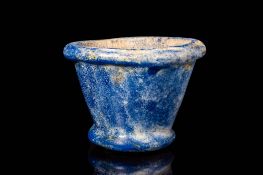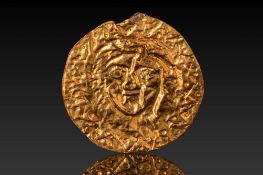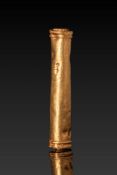Verfeinern Sie Ihre Suche
Auktionshaus-Kategorie
- Achaemenid (1)
- African Art (1)
- Amlash (1)
- Anatolian (1)
- Anglo-Saxon (2)
- Assyro-babylonian (1)
- Bactrian (2)
- Bronze Age (5)
- Byzantine (33)
- Canaanite (1)
- Canosan (1)
- Celtic (3)
- Crusaders (1)
- Cypriot (5)
- Daunian (4)
- Egyptian (150)
- Etruscan (4)
- Gandharan (4)
- Graeco-Roman (1)
- Greek (48)
- Hellenistic (13)
- Inuit (1)
- Iron Age (2)
- Merovingian (4)
- Mesopotamian (5)
- Minerals (5)
- Minoan (1)
- Mittelalterlich (26)
- Moche (1)
- Mughal (1)
- Neo-assyrian (4)
- Neoclassical (1)
- Palmyrian (1)
- Phoenician (9)
- Post-medieval (1)
- Renaissance (2)
- Roman (93)
- Romano-Egyptian (10)
- Sasanian (5)
- Scythian (4)
- Stamp seals (6)
- Syro-Hittite (1)
- Umayyad (3)
- Viking (12)
- Western Asiatic (7)
- 中文 (1)
Kategorie
- Schmuck (157)
- Präparate & Naturkundliches (86)
- Griechische, Römische, Ägyptische & andere Antiquitäten (64)
- Glas & Kristall (31)
- Varia (24)
- Skulpturen (23)
- Waffen, Rüstungen & Militaria (19)
- Großuhren (16)
- Münzen (12)
- Bücher, Manuskripte & Schriften (9)
- Metalle (9)
- Historische Baustoffe & Elemente (8)
- Keramik, Fayencen (8)
- Textilien (7)
- Spielzeug, Modelle & Puppen (5)
- China (4)
- Porzellan (4)
- Vintage Fashion (3)
- Silber & Versilbertes (2)
- Werkzeug (2)
- Wissenschaftliche Instrumente (2)
- Barometer (1)
- Ethnographie & Stammeskunst (1)
- Gemälde & Mischtechniken (1)
- Islam (1)
- Küchenutensilien (1)
- Sport Memorabilia & Equipment (1)
Künstler / Marke
- Liste
- Galerie
-
501 Los(e)/Seite
Ca. 1550 - 332 BC. A collection of faience pendants and beads, including a Sekhmet aegis, goddess Taweret shown in profile holding the sa and ank...
Ca. 1550 - 332 BC. A collection of nine faience rectangular spacer beads pierced with multiple rows of holes, some plain and others decorated wit...
Ca. 1550 - 332 BC. A large collection of faience and glass pendants and beads of various shapes, including tubular, biconical, spherical, disc-sh...
New Kingdom, Ca. 1550 - 1069 BC. A restrung necklace composed of numerous small disc-shaped faience beads in alternating colours, from which at r...
Late Period, Ca. 664 - 332 BC. A large collection of faience beads in shades of blue and green, comprising primarily biconical forms. Reviewed by...
COLLECTION OF ANTIQUITIES
Late Period to Viking Period, Ca. 664 BC - AD 1100. A collection of ancient objects including an Egyptian faience bead of spherical form with a c...
Ca. 1550 - 332 BC. A large collection of faience beads in shades of turquoise, blue, and green, comprising primarily tubular forms with occasiona...
Ca. 1550 - 332 BC. A large collection of faience beads in shades of turquoise, blue, green, white, and brown, comprising numerous tubular, ring, ...
New Kingdom, Ca. 1500 - 1069 BC. An offering vessel made of blue faience, with a conical body that widens towards a thick, rounded rim and rests o...
New Kingdom, Ca. 1550 - 1069 BC. A collection of amulets, pendants, and beads in faience and glass, including a faience hedgehog scaraboid with d...
New Kingdom, Ca. 1550 - 1069 BC. A collection of five faience pendants in varying shades of turquoise and blue. From left to right: a djed-pillar...
New Kingdom, Ca. 1550 - 1069 BC. A matched pair of cornflower pendants in glazed faience, each composed of a flaring blue calyx above a green, tex...
EGYPTIAN FAIENCE CORNFLOWER
New Kingdom, Ca. 1550 - 1069 BC. A cornflower in glazed faience with a flaring calyx in cobalt blue and a bulbous ovary in pale green. The calyx ...
New Kingdom, Ca. 1550 - 1069 BC. A pair of faience pendants in turquoise-green glaze. The pendant on the left is modelled as a cluster of grapes,...
Third Intermediate Period, Ca. 1069 - 664 BC. A faience stamp seal in the form of a recumbent goat, rendered in blue glaze with black detailing. ...
New Kingdom, Ca. 1550 - 1069 BC. A collection of four faience pendants, each depicting Horus the Child in a squatting position with one finger ra...
New Kingdom, Ca. 1550 - 1069 BC. A collection of six blue faience pendants modelled in stylised palmette form, each with a flaring, lobed base an...
Late Period - Ptolemaic Period, Ca. 664 - 30 BC. A faience amulet modelled in the form of a sphinx, seated on an integral rectangular base, with ...
EGYPTIAN FAIENCE CAT AMULET
Late Period - Ptolemaic Period, Ca. 664 - 30 BC. A pale blue faience amulet in the form of a seated cat with its forelegs extended and head held ...
New Kingdom, Ca. 1550 - 1069 BC. A collection of faience pendants and amulets, including a yellow-glazed pendant in the form of a lotus bud with ...
EGYPTIAN FAIENCE FROG AMULET
Late Period - Ptolemaic Period, Ca. 664 - 30 BC. A pale green faience amulet in the form of a crouching frog, modelled in the round and set upon ...
EGYPTIAN FAIENCE SCARABOID DUCK
New Kingdom, Ca. 1550 - 1069 BC. A yellow faience scaraboid amulet in the form of a recumbent duck with its head turned back across the body. The...
Late Period - Ptolemaic Period, Ca. 664 - 30 BC. A rectangular amulet of blue faience with three moulded frogs in squatting posture on the upper ...
EGYPTIAN FAIENCE FROG AMULET
New Kingdom, Ca. 1550 - 1069 BC. A faience amulet in the form of a frog, glazed in deep red with contrasting yellow eyes. The body is contoured w...
New Kingdom, Ca. 1550 - 1069 BC. A collection of three scaraboid frog amulets, each pierced lengthwise through the base and engraved on the unders...
New Kingdom, Ca. 1550 - 1069 BC. A collection of four scaraboid frog amulets and one scarab, each pierced lengthwise through the base and engraved...
Ca. 1356 - 1336 BC. A blue faience grape cluster. It has a sapphire-blue colour and would have been used for decoration. The grapes are depicted u...
Late Middle Kingdom - Early New Kingdom, Ca. 1802 - 1450 BC. A blue faience amulet in the form of a Horus falcon, shown with a short hooked beak ...
New Kingdom, Ca. 1550 - 1069 BC. A collection of three scaraboid frog amulets in blue faience, each pierced lengthwise through the base and engra...
New Kingdom, Ca. 1550 - 1069 BC. A collection of four circular blue glass pendants, each pierced with a central hole and six smaller peripheral h...
Ca. 1550 - 332 BC. A large collection of faience beads in shades of turquoise, blue, green, white, yellow, and brown, comprising numerous tubular...
New Kingdom to Ptolemaic Period, Ca. 1550 - 30 BC. A collection of three amulets. The one on the left is a turquoise-blue faience amulet of Patai...
New Kingdom to Ptolemaic Period, Ca. 1550 - 30 BC. A collection of faience beads in a variety of shapes, including ring-shaped, spherical, cylind...
Ca. 100 BC - AD 200. A collection of glass beads of varying shapes, including ring-shaped, spherical, cylindrical, biconical, hexagonal, and leaf...
PHOENICIAN MOSAIC GLASS EYE BEAD
Ca. 600 - 300 BC. An oblong glass bead with a pale core and surface decoration consisting of alternating vertical bands of blue and yellow framin...
PHOENICIAN STONE FISH AMULET
Ca. 400 BC. A pale stone amulet in the form of a fish, with a broad, ovoid body and a narrow tail ending in a notched caudal fin. Both sides are s...
Ca. 100 BC - AD 200. A collection of beads and decorative elements. The group includes disc- and rod-shaped beads, plaques with concentric decora...
Ca. 100 BC - AD 200. A collection of faience and glass beads in various shapes, including ring-shaped, spherical, cylindrical, and biconical form...
Ca. 30 BC - AD 200. A polychrome glass inlay fragment depicting a stylised swan in profile, against a yellow ground. The body is rendered in blue...
Ca. 30 BC - AD 100. A faience unguentarium with a short, cylindrical neck and a tapering ovoid body, decorated around the shoulder with applied el...
Ca. AD 100 - 200. A terracotta oil lamp shaped in the form of a fish, with the head forming the spout and the body serving as the reservoir. The s...
Ca. 600 - 300 BC. A large collection of beads in mosaic, translucent, opaque, glass and faience, comprising five dark brown and black mosaic glas...
Late Period, Ca. 664 - 332 BC. A collection of five faience beads, including three large spherical beige beads with brown circular patterns, one ...
Ca. 600 - 300 BC. A collection of three restrung necklaces. The uppermost necklace consists of multicoloured small disc beads interspersed with s...
LARGE DAUNIAN JUG WITH RED BANDS
Ca. 550 BC. A large terracotta jug with ovoid body, sloping neck, pronounced mouth and single arching strap handle, decorated in ochre with horiz...
Ca. 330 - 280 BC. A wheel-thrown terracotta oinochoe with tall, inverted piriform body, trefoil mouth, and high-swung handle, decorated in applie...
Ca. 400 - 200 BC. A tapered carnelian gem with a smooth, polished surface and pointed tip set into a cylindrical gold cap decorated with applied s...
Ca. 300 - 100 BC. A gold medallion of thin hammered sheet, repoussé-worked with the frontal head of a Gorgoneion, framed by a border of punched do...
Ca. 300 - 100 BC. A matched pair of gold earrings, each formed as a crescent modelled in the round, applied with twisted wire edging. The lower ed...
Ca. 300 - 100 BC. A gold earring composed of a circular wire hoop with a hooked fastening, embellished along the lower edge with a row of hollow b...
Ca. 330 - 100 BC. A gold pendant of biconical form. Each half tapers to a point and is decorated with concentric ribbing and applied filigree. The...
Ca. 325 - 300 BC. A wheel-thrown terracotta oinochoe covered in a black gloss slip, with a trefoil mouth and a single handle arching from the shou...
Ca. 500 - 300 BC. A gold pendant of circular form with a raised central boss encircled by a concentric band, bordered by a ring of evenly spaced ...
Ca. 600 - 300 BC. A medallion crafted from gold sheet, with a central domed boss surrounded by a concentric band of short engraved lines. An outer...
Ca. 400 BC. A tubular gold bead formed from a sheet wrapped into a cylinder, with both ends finished by applied collars and rings of granulated p...
Ca. 330 - 280 BC. A terracotta skyphos with a deep hemispherical bowl, straight rim, and a pair of horizontal handles. Decorated in added white, y...
GREEK BRONZE MESOMPHALOS BOWL
Ca. 500 - 300 BC. A bronze bowl formed with a broad, shallow body and slightly flaring rim. The base with a pronounced central omphalos encircled...
Ca. 330 - 300 BC. A wheel-made terracotta oinochoe with trefoil mouth, short neck and ovoid body tapering gently to a ring foot. Decorated in the ...
Ca. 350 BC. A terracotta kylix with a broad shallow bowl and twin high-swung handles set horizontally. The interior depicts a central swan in appl...
Ca. 400 - 300 BC. A wheel-made terracotta guttus with a flattened, globular body on a ring foot, a vertical strap handle, and a flaring spout. Th...
-
501 Los(e)/Seite






























































